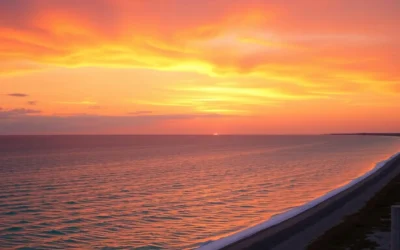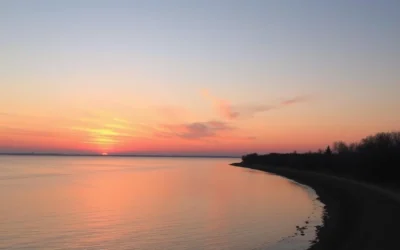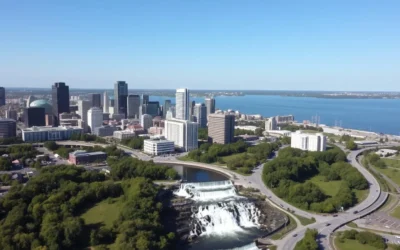Nestled between the turquoise waters of Georgian Bay and Lake Huron, Bruce Peninsula National Park is home to over 20 species of wild orchids and limestone cliffs that are over 400 million years old—predating even the Rocky Mountains. This geological marvel, part of the UNESCO Niagara Escarpment World Biosphere Reserve, offers some of Canada’s most spectacular scenery and diverse ecosystems within its 154 km² (59 sq mi) boundaries.
From the crystal-clear waters of the iconic Grotto to ancient cedar forests clinging to rugged cliffs, Bruce Peninsula National Park delivers natural wonders that draw nearly half a million visitors annually. Whether you’re an avid hiker, a photography enthusiast, or simply seeking a peaceful retreat in nature, this comprehensive guide will help you discover the very best this Ontario gem has to offer.
Planning Your Journey to Bruce Peninsula National Park
Located approximately 300 km (186 mi) northwest of Toronto, Bruce Peninsula National Park requires some planning to ensure a smooth visit. The park has become increasingly popular in recent years, making advance reservations essential during peak season.
Getting There
The most convenient way to reach Bruce Peninsula National Park is by car. From Toronto, take Highway 400 north to Highway 10, then follow it to Wiarton before continuing north on Highway 6 to the park entrance near Tobermory. The drive takes approximately 3.5-4 hours depending on traffic.
If you don’t have your own vehicle, you can take the Parkbus service from Toronto, which operates during summer months. However, once at the park, having a car is highly recommended as attractions are spread out and public transportation within the park is non-existent.
Ready to Start Your Bruce Peninsula Adventure?
Book your transportation now to secure the best rates for your journey.
Park Reservations
Due to the park’s popularity, advance reservations are mandatory for visiting key attractions like the Grotto during peak season (May to October). Parking passes and camping spots at Cyprus Lake Campground also require advance booking through the Parks Canada reservation system, often months ahead for summer visits.
Best Time to Visit Bruce Peninsula National Park
The park is open year-round, but the experience varies dramatically with the seasons. Understanding the best time to visit can make or break your Bruce Peninsula adventure.
Summer (June-August)
Peak season with warm temperatures of 20-25°C (68-77°F). Perfect for swimming in the clear waters, but expect crowds and required reservations for popular spots like the Grotto.
Fall (September-October)
Spectacular fall colors, fewer crowds, and water still warm enough for swimming. Temperatures range from 10-18°C (50-64°F), making it ideal for hiking the Bruce Trail.
Spring (May-June)
Wildflowers bloom and wildlife becomes active. Temperatures range from 10-20°C (50-68°F), but water is too cold for swimming. Great for photography and peaceful hiking.
Winter Advisory: While the park remains open in winter (November-April), services are extremely limited. Many roads are not maintained, and trails can be dangerously icy. Only visit during winter if you’re experienced with winter hiking and properly equipped.
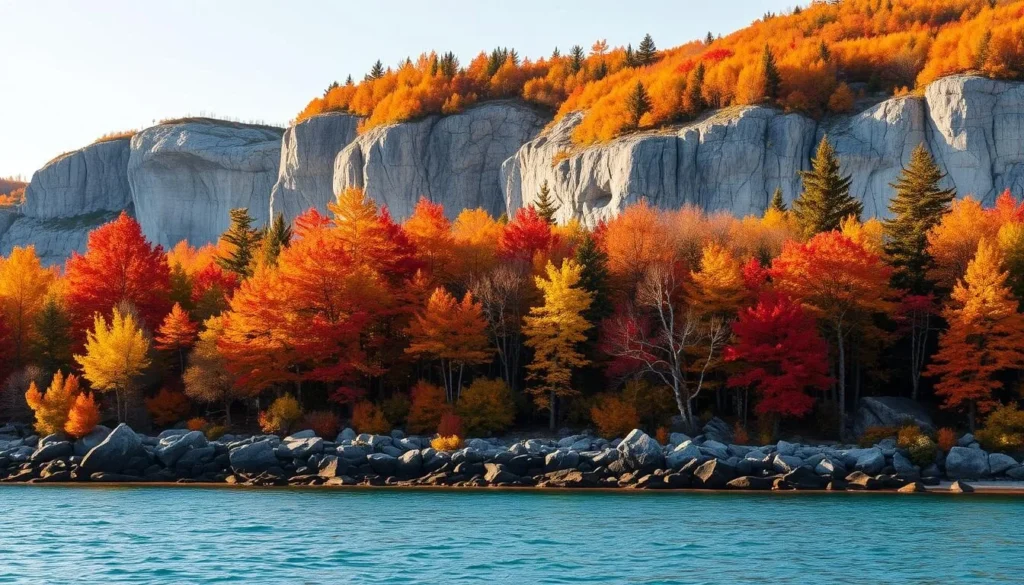
Top Attractions in Bruce Peninsula National Park
Bruce Peninsula National Park offers several world-class natural attractions that should be on every visitor’s itinerary. Here are the absolute must-see spots that showcase the park’s unique beauty.
The Grotto
The crown jewel of Bruce Peninsula National Park, the Grotto is a stunning natural sea cave with crystal-clear turquoise waters. Formed over thousands of years by wave action eroding the limestone cliffs, this geological wonder offers one of the most photographed scenes in Ontario.
To reach the Grotto, you’ll need to hike approximately 45 minutes from the Cyprus Lake parking area along rocky terrain. During peak season (May-October), advance parking reservations are mandatory and limited to 4-hour time slots.
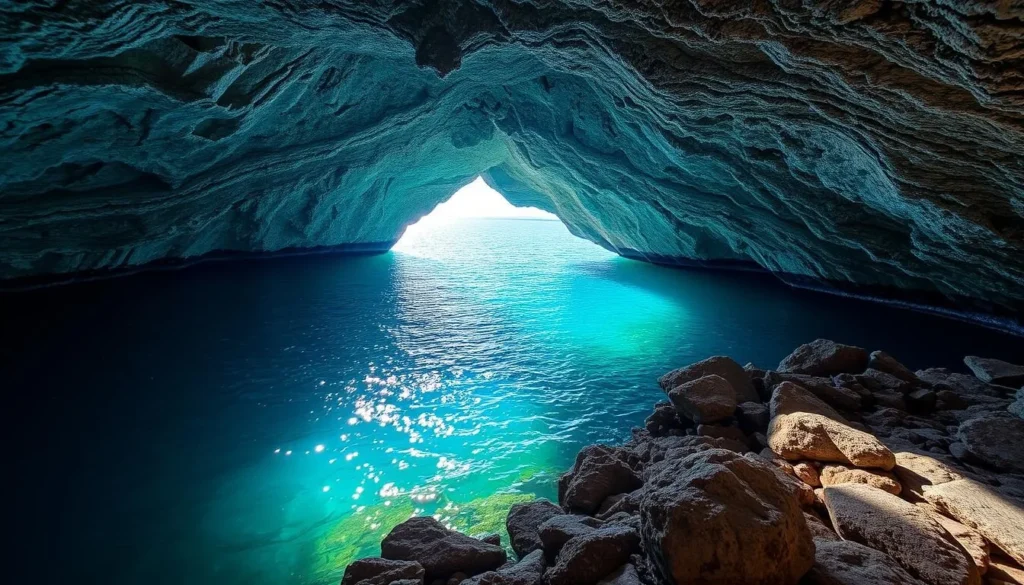
Indian Head Cove
Located just a short walk from the Grotto, Indian Head Cove features a picturesque pebble beach with the same stunning turquoise waters. The shallow, protected cove makes it one of the best swimming spots in the park when weather permits, though the water remains quite cold even in summer.
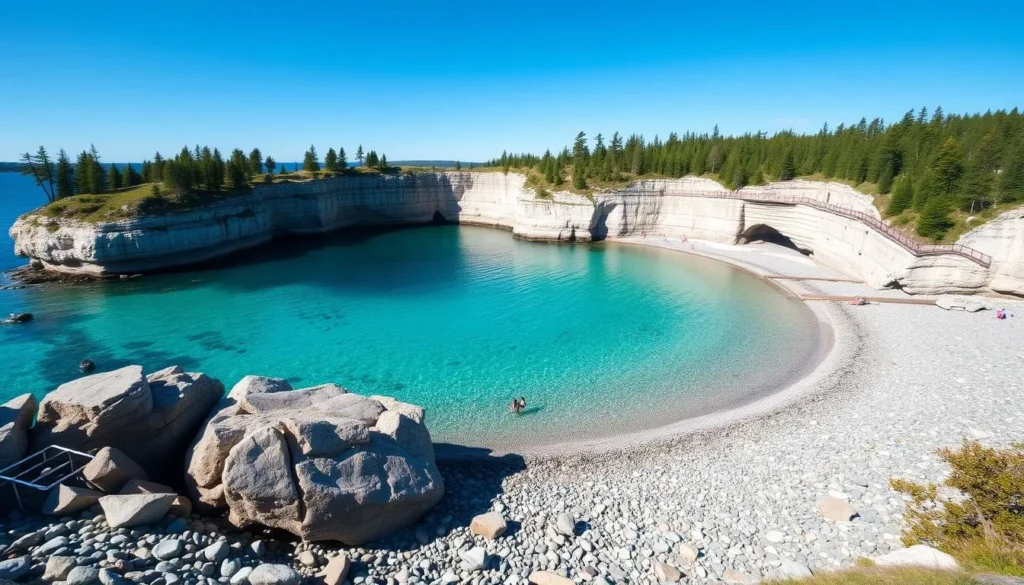
Flowerpot Island
While technically part of the adjacent Fathom Five National Marine Park, Flowerpot Island is a must-visit destination accessible by boat from Tobermory. The island is famous for its unique “flowerpot” rock formations—sea stacks shaped by thousands of years of wave erosion.
Visitors can explore the island’s 4.3 km (2.7 mi) of hiking trails, visit a historic lighthouse, and marvel at the ancient cedars growing from seemingly impossible rock crevices. Tour boats operate from May to October, with advance booking recommended during peak season.
Experience the Best of Bruce Peninsula
Book guided tours to ensure you don’t miss any of these natural wonders.
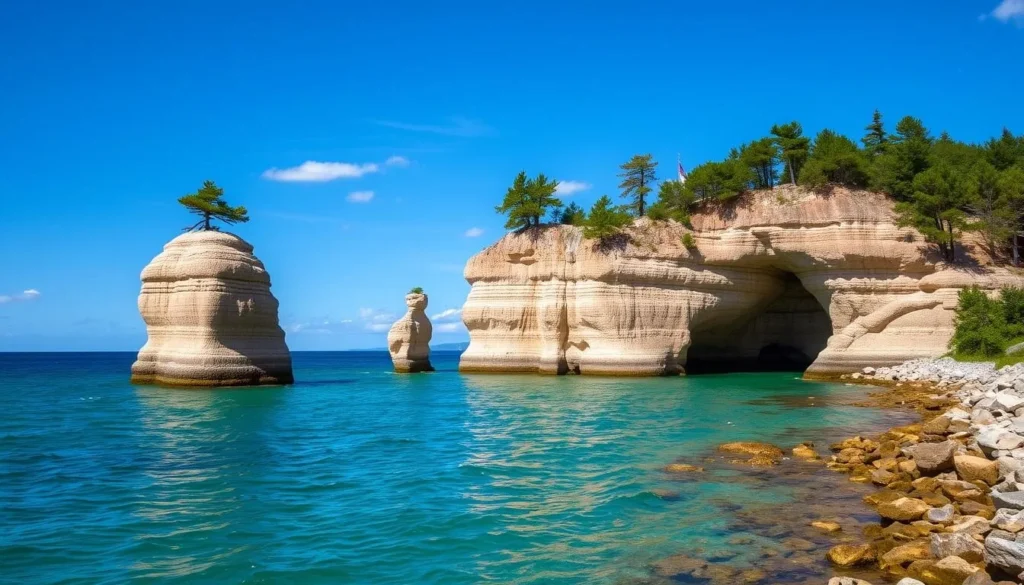
Best Hiking Trails in Bruce Peninsula National Park
With over 30 km (18.6 mi) of trails ranging from easy boardwalks to challenging rocky paths, Bruce Peninsula National Park offers hiking experiences for all skill levels. The park contains a portion of the famous 900 km (559 mi) Bruce Trail, Canada’s oldest and longest marked hiking trail.
Bruce Trail to the Grotto
Distance: 4 km (2.5 mi) round trip
Difficulty: Moderate
Time: 1.5-2 hours
The most popular trail in the park takes you from the Cyprus Lake parking area to the Grotto and Indian Head Cove. The trail features rocky terrain with some moderate climbs and spectacular views of Georgian Bay.
Marr Lake Trail
Distance: 3 km (1.9 mi) loop
Difficulty: Easy
Time: 1 hour
This family-friendly loop trail circles Marr Lake through beautiful mixed forests. The relatively flat terrain makes it accessible for most visitors, with opportunities to spot wildlife and various plant species.
Boulder Beach Trail
Distance: 3.2 km (2 mi) one-way
Difficulty: Moderate to difficult
Time: 2-3 hours
This challenging trail follows the Georgian Bay shoreline from the Grotto to Boulder Beach, featuring rugged terrain and spectacular views. The massive shoreline boulders create a natural playground for exploration.
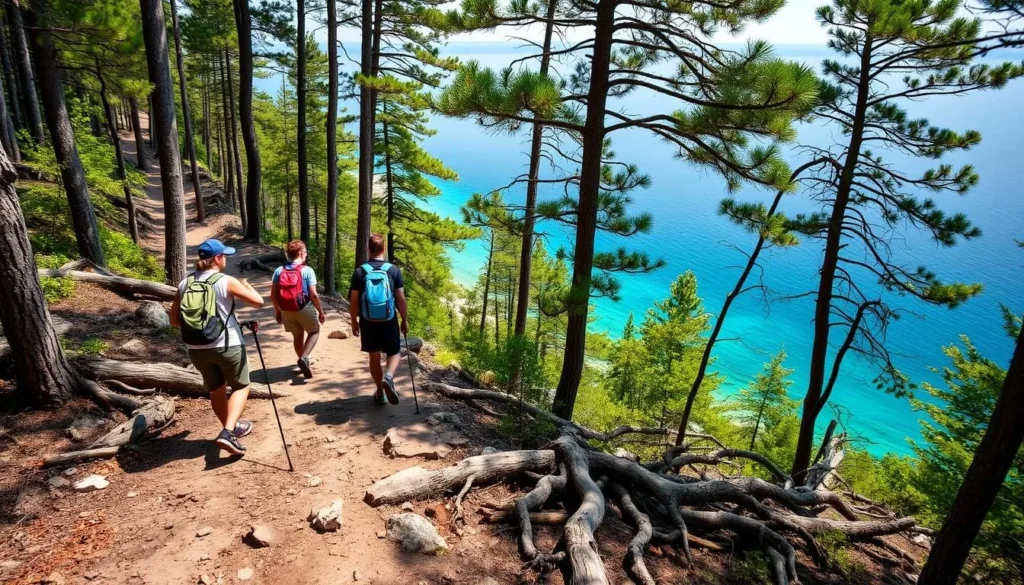
Hiking Safety Tips: Always stay on marked trails, wear sturdy footwear, carry sufficient water, and check weather conditions before setting out. Cell service is limited in many areas of the park, so consider bringing a paper map. Inform someone of your planned route and expected return time.
Beaches and Swimming Spots
While Bruce Peninsula National Park is known for its dramatic cliffs, it also offers several beautiful beaches and swimming areas. The water is typically quite cold, even in summer, but the crystal-clear turquoise color makes for an unforgettable swimming experience.
Singing Sands
Located on the Lake Huron side of the peninsula near Dorcas Bay, Singing Sands (also known as Dorcas Bay Beach) features a shallow, sandy beach that’s perfect for families. The water stays shallow for a considerable distance, making it warmer than other swimming spots in the park. The beach gets its name from the sound the sand sometimes makes when walked upon.
Singing Sands is also home to rare and fragile dune ecosystems and features a short boardwalk trail through wetlands. Facilities include washrooms, picnic areas, and parking (no reservation required).
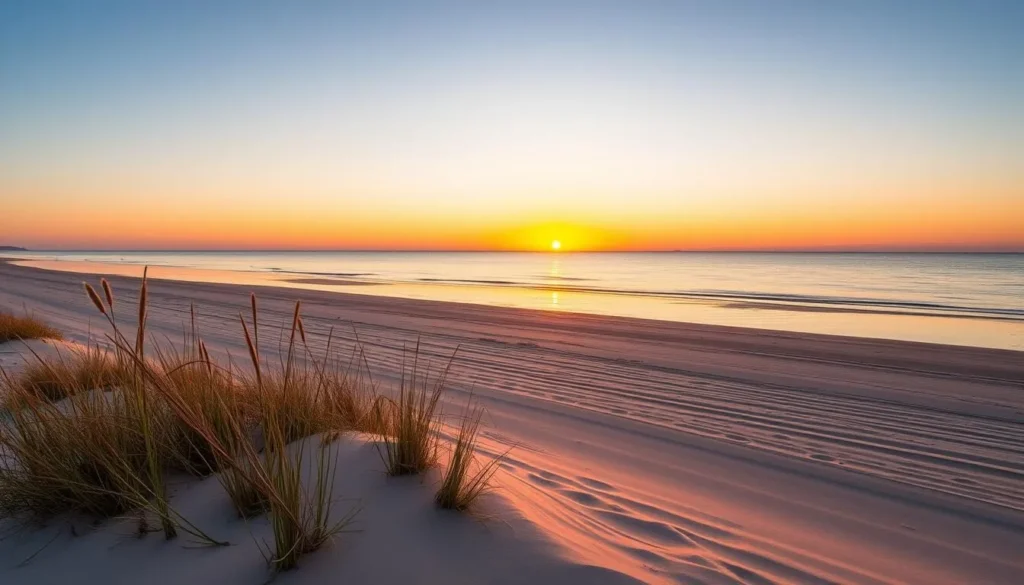
Halfway Log Dump
This pebble beach on the Georgian Bay side offers a less crowded alternative to the Grotto area. The clear, turquoise waters are stunning, though the rocky shore makes water shoes advisable. Reaching the beach requires a moderate 1 km (0.6 mi) hike from the parking lot.
During peak season (July-August), parking reservations are required through the Parks Canada reservation system.
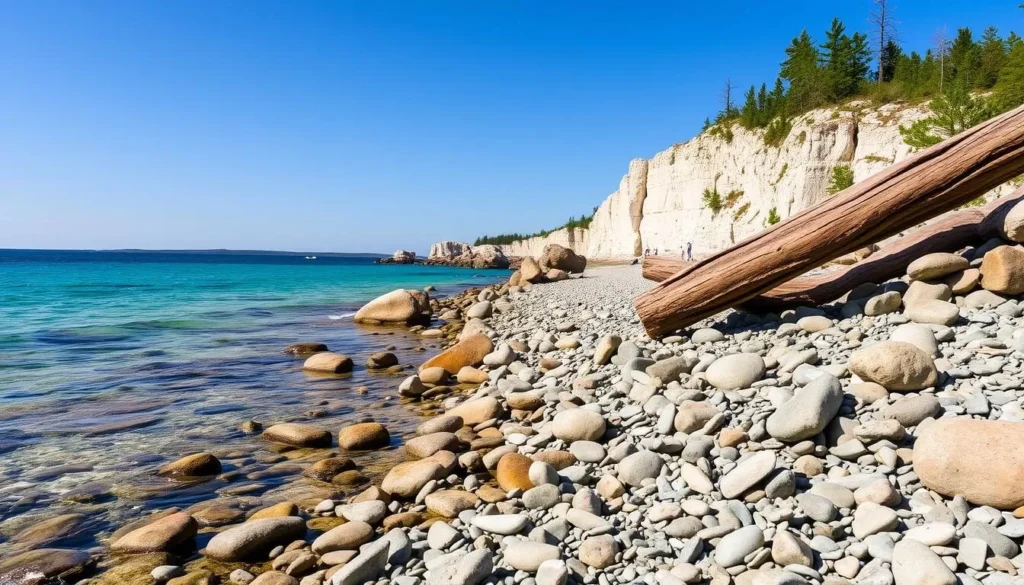
“The water at Bruce Peninsula is so clear and such a vibrant shade of turquoise that first-time visitors often think the photos must be heavily edited—until they see it with their own eyes.”
Where to Stay at Bruce Peninsula National Park
From camping under the stars to comfortable accommodations in nearby Tobermory, there are options for every preference and budget when visiting Bruce Peninsula National Park.
Camping Within the Park
Cyprus Lake Campground offers the only front-country camping within Bruce Peninsula National Park. Located just 1.5 km (0.9 mi) from the Grotto, this popular campground features:
- 242 drive-in campsites (no electrical hookups)
- Flush toilets and potable water
- Fire pits and picnic tables
- Nearby hiking trails
Reservations are essential and can be made through the Parks Canada reservation system up to 6 months in advance. Sites typically book up within minutes of becoming available for July and August dates.
Yurts and Backcountry Camping
For a unique experience, the park offers six yurts (circular tent structures with beds) at Cyprus Lake Campground. For those seeking more solitude, backcountry camping is available at Stormhaven and High Dump, accessible only by hiking along the Bruce Trail.
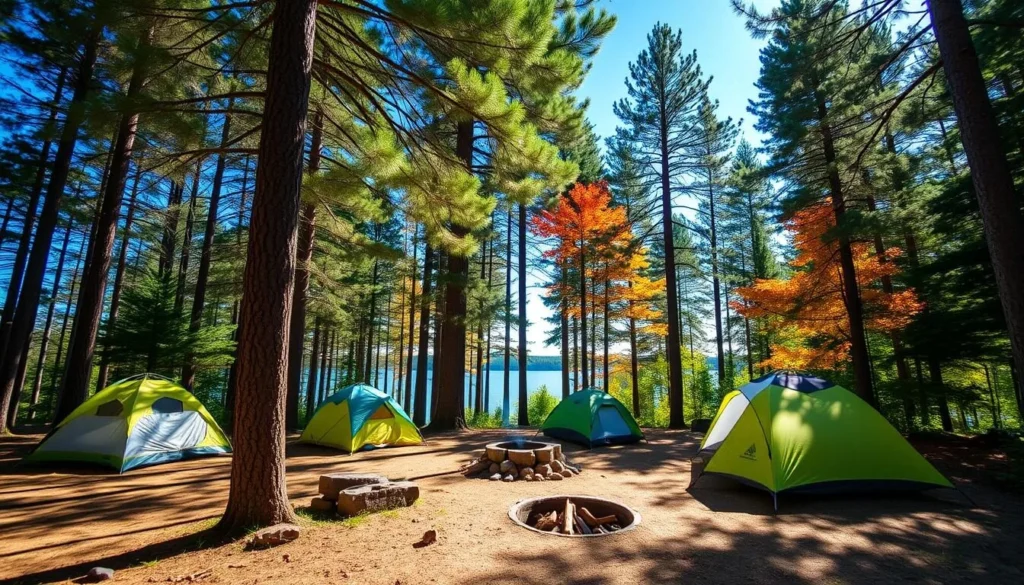
Accommodations Near the Park
The town of Tobermory, located just 10 minutes from the park entrance, offers various accommodation options including:
- Hotels and motels
- Bed and breakfasts
- Cottage rentals
- Private campgrounds
Find Your Perfect Stay
Book accommodations early to secure the best options for your Bruce Peninsula adventure.
Essential Tips for Visiting Bruce Peninsula National Park
Make the most of your visit to Bruce Peninsula National Park with these practical tips that will help you avoid common pitfalls and enhance your experience.
Plan Ahead
- Make reservations months in advance for camping and Grotto parking
- Consider visiting on weekdays or shoulder seasons to avoid crowds
- Download offline maps as cell service is limited in the park
- Check the Parks Canada website for current conditions and closures
What to Bring
- Sturdy hiking shoes with good grip for rocky terrain
- Layered clothing (temperatures can vary significantly)
- Water shoes for swimming in rocky areas
- Insect repellent (especially May-July)
- Reusable water bottle and sufficient water for hiking
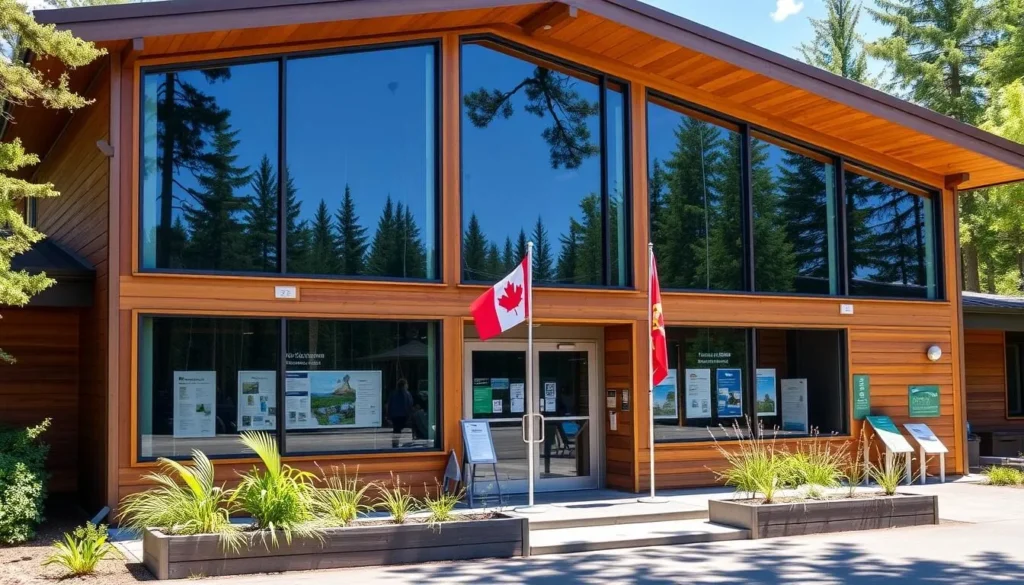
Safety Considerations
Bruce Peninsula National Park features rugged terrain and potentially dangerous conditions that require awareness:
- Cliff edges are extremely dangerous and have no guardrails in many areas
- Swimming conditions can change rapidly; there are no lifeguards
- Black bears are present in the park; store food properly and carry bear spray
- Weather can change quickly; check forecasts and be prepared
- Poison ivy is common along some trails; learn to identify and avoid it
Park Fees: A valid Parks Canada pass is required to visit Bruce Peninsula National Park. Daily passes can be purchased at the visitor center or park entrance. Consider a Discovery Pass if you plan to visit multiple national parks within a year.
Exploring Beyond Bruce Peninsula National Park
While Bruce Peninsula National Park offers enough activities to fill several days, the surrounding area has additional attractions worth exploring during your visit.
Fathom Five National Marine Park
Adjacent to Bruce Peninsula National Park, Fathom Five National Marine Park protects 22 shipwrecks and several islands in Lake Huron. Glass-bottom boat tours from Tobermory offer views of shipwrecks in the crystal-clear waters, while scuba diving provides a more immersive experience for certified divers.
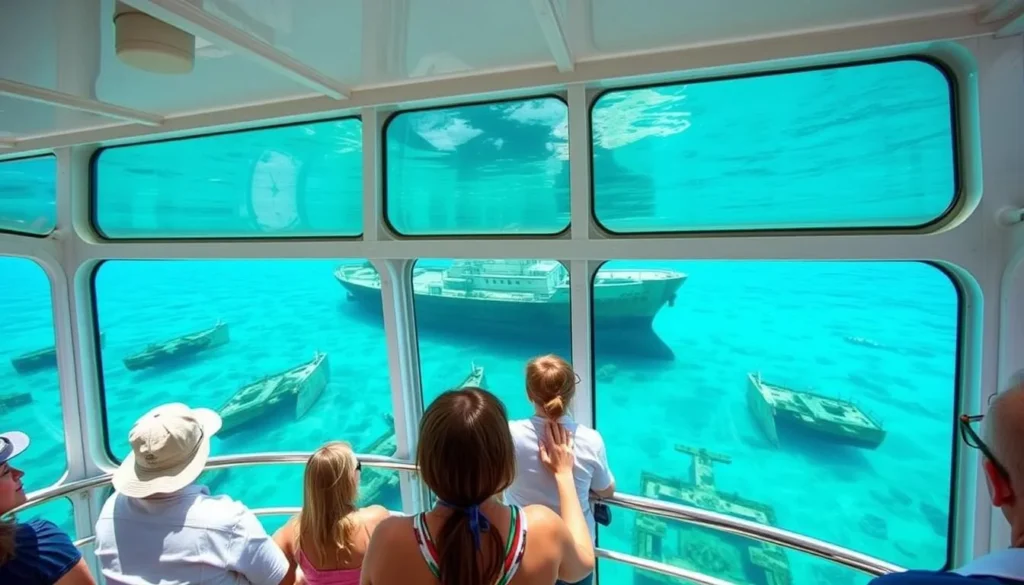
Tobermory
The charming harbor town of Tobermory serves as the gateway to both national parks. Explore the picturesque Little Tub Harbour with its shops and restaurants, visit the Chi-Cheemaun Ferry terminal, or enjoy fresh whitefish at a local eatery.
Lion’s Head
This small village 30 minutes south of the park features the Lion’s Head Lookout Trail, offering spectacular views of Georgian Bay from atop limestone cliffs. The harbor area provides a peaceful setting for watching boats and enjoying local cuisine.
Ready for Your Bruce Peninsula Adventure?
Start planning your perfect trip today with these essential resources.
Book Flights
Find Accommodations
Reserve a Rental Car
Explore Tours & Activities
Conclusion: Your Bruce Peninsula National Park Adventure Awaits
Bruce Peninsula National Park represents one of Canada’s most spectacular natural treasures, where ancient limestone cliffs meet the crystal-clear waters of Georgian Bay. From the iconic Grotto to peaceful forest trails and stunning beaches, the park offers experiences that will create lasting memories for nature lovers, photographers, hikers, and families alike.
By planning ahead, respecting the fragile ecosystems, and following the practical advice in this guide, you’ll be well-prepared to experience the best that Bruce Peninsula National Park has to offer. Whether you’re swimming in the turquoise waters, hiking along dramatic cliffs, or simply soaking in the tranquility of this natural wonder, your adventure in this Ontario gem promises to be unforgettable.
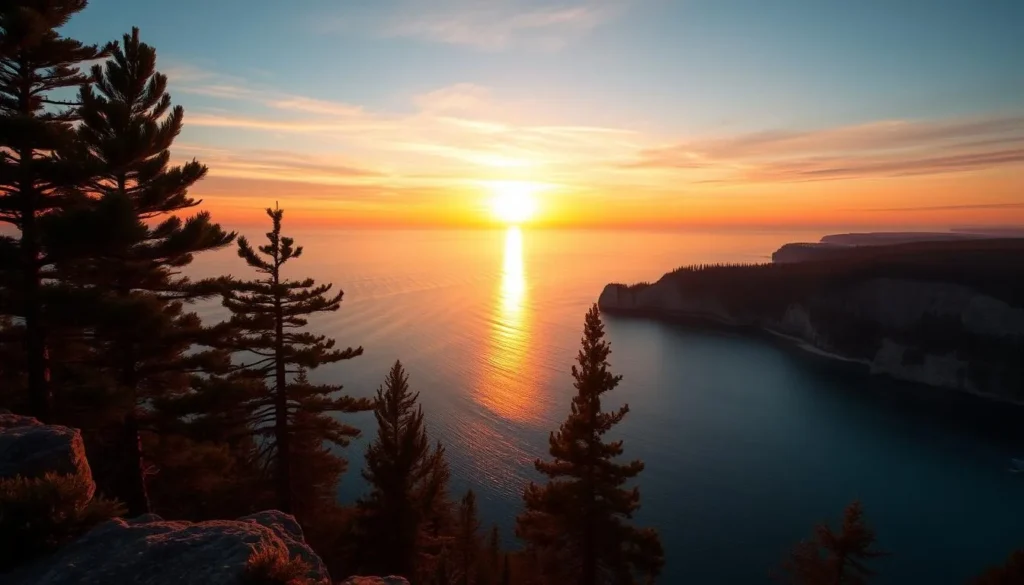
The above is subject to change.
Check back often to TRAVEL.COM for the latest travel tips and deals.

